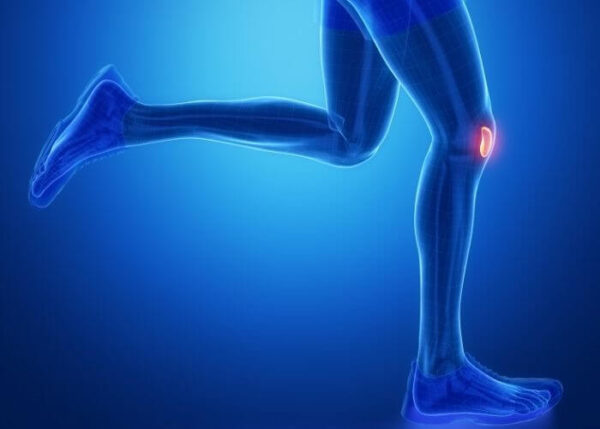What is Patella Instability?
The patella, or kneecap, is the bone on the front of your knee that resides within the tendon of your quadriceps. Its main function is to improve the mechanical advantage of your quad and give it more power. It sits in a groove at the end of the femur called the trochlear groove. The patella is held in place in the trochlear groove by strong ligaments and tendons and when it moves outside of this groove, patellar instability occurs.
Almost all patella dislocations are lateral (the knee cap dislocates to the outside). When this occurs, the medial patellofemoral ligament, or MPFL tears or stretches. Dr. Armando Vidal, orthopedic knee specialist has been successfully treating patients in Vail, Aspen and the surrounding Denver, Colorado communities who have patella instability.

What types of Patellar instability are there?
Generally, there are two types of patellar instability:
Traumatic patellar dislocation: Instability as a result of a traumatic event, fall, accident or sports injury where the patella is pushed completely out of its groove in the femur. This can happen with a dislocation and usually involves other ligaments.
Patella subluxation: Subluxation occurs when the kneecap slides partly out of the groove. This can happen repeatedly which causes strain on the medial patellofemoral ligament, resulting in knee pain and a sense of giving way.
Are athletes more prone to patella instability?
Individuals who are at a higher risk for patellar instability include young women who are loose jointed as well as athletes who experience a traumatic knee dislocation while participating in their sport. These individuals share common physical variations that attribute to the likelihood of patella instability. Those include:
- Patients with malalignment, or a “knocked-knee” appearance.
- Individuals with patella alta – or a high-riding kneecap
- A shallow or non-existent groove on the trochlea or femur
- An abnormal insertion of the patellar tendon on the tibia (shin). (Normal insertion keeps the kneecap in line with the tibia.)
What are the symptoms of patella instability?
The most common symptom of patella instability is either a complete dislocation (not a subtle diagnosis) or more subtly, a sense of sliding out of the patella from the groove. Surprisingly, pain is not always an indication of patella instability. Orthopedic knee specialist, Dr. Armando Vidal advises patients in Vail, Aspen and the surrounding Denver, Colorado communities that pain and instability don’t always go together. It is not unusual for the knee to quit hurting after a dislocation and between instability episodes. Dr. Vidal advises patients to seek treatment, even if they are not experiencing pain, because cartilage damage continues to progress with each recurring subluxation or dislocation. Other symptoms in which patients should seek out Dr. Vidal’s expertise are:
- Buckling, catching or locking sensation in the knee
- Sensation that the kneecap has moved out of place
- Nagging ache under the kneecap, especially with deep knee bending
- Noticeable deformity in the knee
How is patella instability diagnosed?
Typically, the diagnosis can be made by a thorough patient history and physical exam. Dr. Vidal will request an MRI after any dislocation to assess the ligaments of the knee. It is also important to check for cartilage damage and loose bodies, which can be a piece of bone or cartilage, torn loose from the dislocation. Loose bodies can cause locking, buckling or additional knee pain if left untreated.
How is patella instability treated?
On occasion, the kneecap will not go back into place if it is dislocated. If this happens, it is important to seek prompt medical care to reduce (put back into place) the patella.
Most first time patella dislocations can be treated non-operatively. The exception is patients who have also developed a loose body or cartilage injury. In these cases, surgery will be needed to remove the loose body, potentially repair the cartilage damage and restore the stability to the patella.
Non-Surgical Treatment:
Depending on the severity of the patella dislocation, Dr. Vidal may prescribe a knee brace and crutches. After a period of rest, he will have the patient begin physical therapy to strengthen the muscles in the knee that will improve knee stability.
Surgical Treatment:
Patients who have recurrent patella instability, or who have recurrent knee dislocations, may require surgery to restore the ligaments that help stabilize the knee. Surgery for patella instability is very individualized and Dr. Vidal will assess the patient for underlying risk factors for future instability. He may recommend a soft tissue procedure, where the torn or stretched medial patellofemoral ligament is repaired or more frequently, reconstructed.
A bony procedure may be recommended if the patient has an abnormality in which the patella tendon causes misalignment with the tibia in such a way that the kneecap is pulled sideways. For this procedure, Dr. Vidal removes a small portion of bone where the tendon attaches and repositions it, allowing the tendon to guide the patella effectively into the trochlear groove. This surgery is called a tibial tubercle osteotomy or transfer.
How long is the recovery after patella instability surgery?
Full recovery for patella instability surgery can take 6-9 months. Patients can expect extensive physical therapy and post-surgery protocols that are individualized for the specific patient and their procedure performed. Most patients without any sign of arthritis in the kneecap can return to full sporting activities between 6-9 months after surgery. Thankfully, surgery to stabilize the patella has a very high success rate and recurrent instability is uncommon.
Knee Instability Specialist
Are you an athlete who experienced a recent knee injury resulting in frequent buckling, a deformity, or the feeling that the knee is out of place? If so, you may be experiencing patella instability. Athletes who have experienced a knee dislocation and young women with loose joints most frequently experience knee instability. Patella instability specialist, Doctor Armando Vidal provides diagnosis as well as arthroscopic stabilization surgery for patients in Vail, Aspen, and the surrounding Denver, Colorado communities who are experiencing knee instability. Contact Dr. Vidal’s team today!

Locations
180 S Frontage Rd W
Vail, CO 81657
226 Lusher Court
Ste 101
Frisco, CO 80443
322 Beard Creek Road
Edwards, CO 81632


